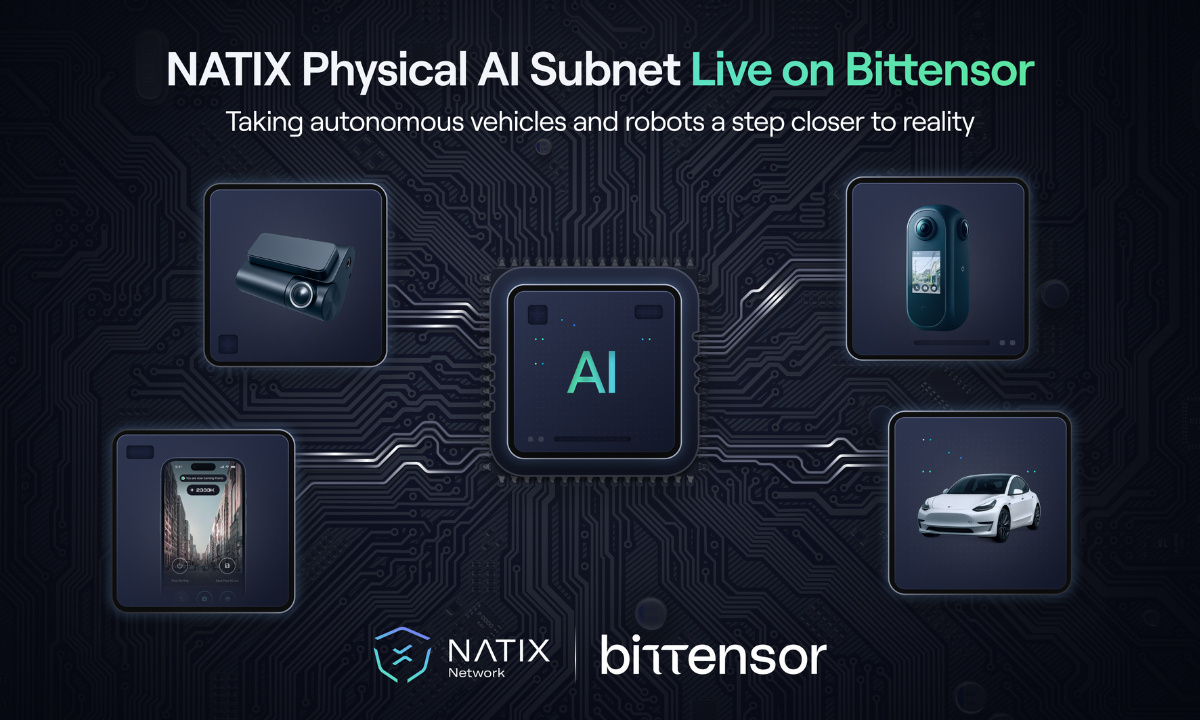
NATIX Launches Decentralized AI Subnet on Bittensor to Advance Autonomous Driving and Physical AI
Hamburg, Germany, May 27th, 2025, Chainwire
The StreetVision Subnet, incubated by Yuma, ingests real-world 360° data from NATIX’s Tesla network (powered by Grab), and processes it to generate critical insights for map-making and Physical AI, while continuously outputting refined AI models.
NATIX Network, a Solana-based DePIN (decentralized physical infrastructure network) of smart cameras that collects street-level visual data for mapping and autonomous driving applications, announces the launch of StreetVision Subnet (Subnet 72) on Bittensor, the leading decentralized machine learning protocol. This strategic move combines NATIX’s extensive real-world data collection network with Bittensor’s decentralized AI infrastructure to significantly enhance autonomous driving and next-generation map-making.
Uber CEO Dara Khosrowshahi recently shared the success of its robotaxis in Austin, Texas, and shared the company’s plan to grow its self-driving fleet after the deal with Waymo “exceeded expectations.” As the role of Physical AI and autonomous vehicles expands, so does the need for safer models, trained using masses of real-world data. Traditional methods of training autonomous driving systems and updating maps involve costly, centralized processes that often fail to promptly capture dynamic, real-world changes. This pain point led enterprises like Nvidia and Uber to invest millions in solutions focused on creating synthetic driving simulations and unpredictable scenarios.
NATIX addresses these limitations by harnessing decentralized networks to continuously collect, analyze, and deploy real-world street-level imagery and video data. With over 250,000 active contributors who have already mapped over 170 million kilometers, NATIX’s global community-driven approach ensures data collection at an unprecedented scale and frequency.
StreetVision Subnet was incubated with strategic guidance from Yuma, a DCG company and key infrastructure partner in the Bittensor ecosystem. Yuma supported the launch through hands-on support, including AI model development and go-to-market collaboration, helping shape the subnet’s reach throughout the network.
NATIX will ingest real-world imagery from NATIX’s Internet of Cameras, gathered through the Drive& app and the VX360 device, developed in collaboration with Grab and leveraging Tesla vehicles’ built-in 360° cameras. The subnet processes these streams, generating valuable insights critical to mapmaking and Physical AI applications. Through competitive decentralization, miners within the subnet continuously refine their AI models, producing increasingly accurate and efficient detections and classifications.
These improved AI models are then seamlessly integrated back into NATIX’s Edge Network, i.e., smartphone and dashcam devices with edge compute power, allowing real-time street-level analysis. This creates a virtuous cycle, continually enhancing the accuracy and responsiveness of real-time detections for map updates and autonomous driving scenarios.
“The NATIX StreetVision Subnet on Bittensor represents the convergence of Physical AI and decentralized intelligence,” said NATIX CEO and co-founder Alireza Ghods. “By decentralizing data analysis, we enable the continuous improvement of AI models, significantly enhancing mapping accuracy, autonomous vehicle safety, and real-world responsiveness.”
“Physical AI is one of the most compelling immediate use cases for decentralized intelligence,” said Yuma’s Chief Revenue Officer Evan Malanga. “NATIX shows how continuous data from the physical environment can directly improve decision-making and enhance products already in use today. At Yuma, we back subnets like NATIX because they connect Bittensor to the real world, a clear signal that decentralized AI is delivering tangible impact.”
Roadwork Detection: The First Milestone
Initially focusing on roadwork detection, NATIX leverages the decentralized competition of Bittensor to develop highly accurate, real-time roadwork classifier AI models. This directly contributes to safer navigation, timely mapping updates, and improved autonomous vehicle performance. NATIX plans to rapidly expand into additional critical use cases, including potholes, road signs, litter detection, and comprehensive infrastructure monitoring.
Moreover, the subnet will later start to classify driving videos into standardized traffic scenarios and rare edge cases essential for training autonomous driving systems. Scenario classifications are integrated into simulation platforms, helping autonomous vehicle developers rigorously test and validate their technologies against real-world conditions, meeting regulatory requirements and enhancing safety.
Operating under Bittensor’s Dynamic TAO (dTAO) model, the StreetVision subnet provides continuous rewards, incentivizing miners and validators who produce high-quality outputs. Participants stake NATIX tokens to secure participation, ensuring sustained commitment and performance. Revenue from monetizing subnet-generated insights supports token buybacks and burning, fostering long-term token value and network sustainability.
About NATIX
Started in Hamburg in 2020, NATIX Network is a decentralized network of smart cameras powered by Solana. NATIX’s AI-powered Drive& app leverages edge computing to crowdsource smartphone cameras and collect real-time geospatial data and map the world around us. Network contributors are rewarded with NATIX’s native cryptocurrency to support better driving-assistant applications (dashcam, navigation, parking availability, etc.) and improve the infrastructure around us. With its recently introduced VX360 for Teslas, the comprehensive 360° imagery collected, NATIX offers a game-changing solution to the future of mapping and autonomous driving. With over 250,000 registered drivers and 170 million kilometers covered, NATIX is the biggest mapping DePIN network globally, according to Messari’s “State of DePIN 2024” report. For more information, users can visit NATIX.network
About Bittensor
Bittensor is a decentralized machine learning network that enables permissionless AI model training and inference. By leveraging a system of interconnected subnets, Bittensor creates an open, scalable, and incentive-driven ecosystem for artificial intelligence.
About Yuma
Yuma is a subsidiary of DCG focused on accelerating decentralized AI through the Bittensor network. Its mission is to create positive economic and societal change by connecting transformative ideas to decentralized intelligence. Yuma supports early-stage teams building on Bittensor, a decentralized network that rewards AI models for useful output, creating an open marketplace for machine intelligence. It provides capital, technical support, community access, and long-term collaboration to help launch and grow subnets. Through its accelerator, incubator, validator, and mining roles, Yuma helps shape a more open and accessible future for AI. Users can learn more at yumaai.com
